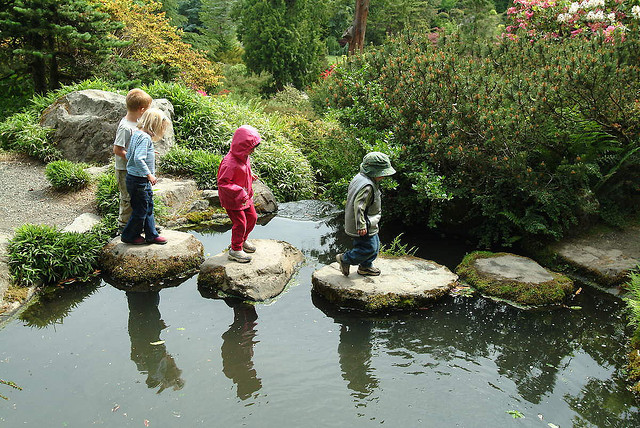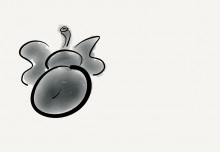
“Some children might not be ready for as big a jump from letter sounds to reading words and sentences and would benefit from making it a few little hops instead of a bigger jump.” – Jordan K., Elementary School Librarian
The Creek Is Wide
Have you ever taken a walk through the woods with your small children and come to a small creek that’s just right for you to stretch your stride out and cross, but is just a bit too wide for you kids’ shorter legs to manage?
Even if they run and jump, they’re going to end up getting wet (which may or may not be a positive thing depending on the child and the circumstances).
If it’s not going to be good, what do you do?
Turn around and go home?
Carry them across?
Both viable options.
But what if you want to continue your walk and also help them gain a sense of accomplishment so that, someday, as they grow in stature, confidence and ability, they can cross the creek themselves?
You might find a nice big rock or two to plonk down in the middle and hold their hand as they take a few hops to cross what, in their eyes and to their legs, is a big wide river.
Use “Inch Pebbles” and Leverage “The Power of Small Wins”
In their amazing book, Switch: How to Change When Change is Hard (can you tell I’m a big fan?!), Chip & Dan Heath advise that we “Shrink the Change” when we are encouraging people to make any change.
The Heath Brothers’ dad used to tell his business’ team members to take projects with distant milestones and break those down into “inch pebbles.”
He was leveraging what Teresa M. Amabile and Steven J. Kramer call “The Power of Small Wins” in their Harvard Business Review article.
Amabile and Kramer state that their research showed that “the more frequently people experience that sense of progress, the more likely they are to be creatively productive in the long run. Whether they are trying to solve a major scientific mystery or simply produce a high-quality product or service, everyday progress—even a small win—can make all the difference in how they feel and perform.”
Hopping Stones
When a child is first learning to read, is there a way we can put hopping stones across what might feel to them like the Mighty Mississippi?
Can we help them have a genuine sense of “everyday progress” that can influence how they feel and perform as they cross Reading River?
Yes! Many teachers are trained to do just that.
After children have learned all the letters and letter sounds, often teachers first focus on getting kids to recognize the first letter of their own name, then to recognize the first letter of other children’s names or familiar words such as Banana or Cat.
After that they may focus on recognizing all the letters in three letter CVC words (CVC = consonant vowel consonant), such as cat, red, or hop.
Oh, You’re Halfway There!
Especially if a child is feeling discouraged that they haven’t been able to make the jump from letters to reading, it may be helpful to give them an extra hopping stone or two, and also to show them that they are already a few stones across Reading River.
The Heath Brothers advise that people tend to be more energized for a longer journey that they have already begun than for a shorter one that they haven’t started, writing: “People find it more motivating to be partly finished with a longer journey than to be at the starting gate of a shorter one.”
So kids would rather be a few stones across a wider river than standing on the bank of a narrower one feeling like they are at square one, or worse, square zero.
Can you help show your child that they are already part way across Reading River or, if you’re in the UK, The River Reading?
Here’s a Hop Across Reading River – Hopping Stones Chart you may want to help your child fill out:
- ____ I know my ABC’s.
- ____ I know the sounds of the letters of the alphabet.
- ____ I can read one letter words: A & I
- ____ I can read two letter words: AM, IT, IS, & UP
- ____ I can read a sentence: IT IS.
- ____ I can read two two word sentences: IT IS. & I AM.
- ____ I can read two three word sentences: IT IS UP. & I AM UP.
- ____ I can read a whole page of a book with help.
- ____ I can read a whole page of a book on my own.
- ____ I can read two pages of a book.
- ____ I can read 1 whole book.
- ____ I can read 2 books.
- ____ I can read 3 books.
- ____ I can read 4 books.
- ____ I can read 5 books.
Short Vowel Shorts Hopping Stones
Each book in the Short Vowel Shorts series gives parents and teachers a few more hopping stones to help kids cross Reading River.
- Only one single short vowel sound per super short book.
- No sight words.
- No lower case letters.
- Only one blend (in Ish Fish & Jin Fin).
- Strong visual clues.
- Complete storylines that invite prediction and making inferences.
Yes, Short Vowel Short could use high frequency/sight words and lower case or cursive letters, but those wouldn’t make the hop absolutely, unequivocally as small as humanly possible to help kids hop a few more stones across Reading River, gaining confidence, a sense of progress, and the encouragement that they are not starting at square zero.
May your learner take one small hop after another until they have the confidence and ability to stretch their stride across the creek themselves.
Download the FREE (draft) Hopping Stones Chart
(If you’re an educator, please know that on my best days, I’m looking to learn not only for myself, but also to improve the resources that are provided to help parents support their children’s learning. Feel free to suggest improvements to the Hopping Stones Chart in the comments below.)
OR
Pick up a copy of Fat Cat vs. Bad Bat (FREE) or Ed Egg vs. Peg Leg Egg and add a few Hopping Stones across your child’s Reading River.
Fat Cat vs. Bad Bad is also available as a pdf FREE on Teachers Pay Teachers.
[Image by Seattle Municipal Archives]
2 Comments
-
What helped our kids the most was reading to them almost everyday when they were little. When we starting using a good phonic program they were already really interested in books. They were so excited when they could read the words themselves.



